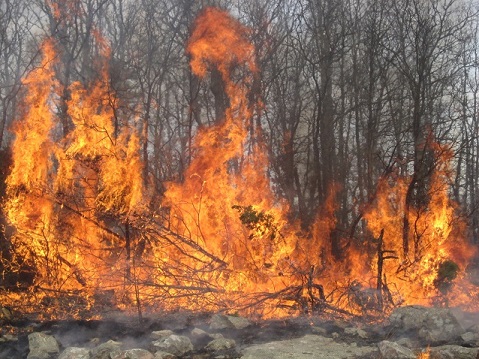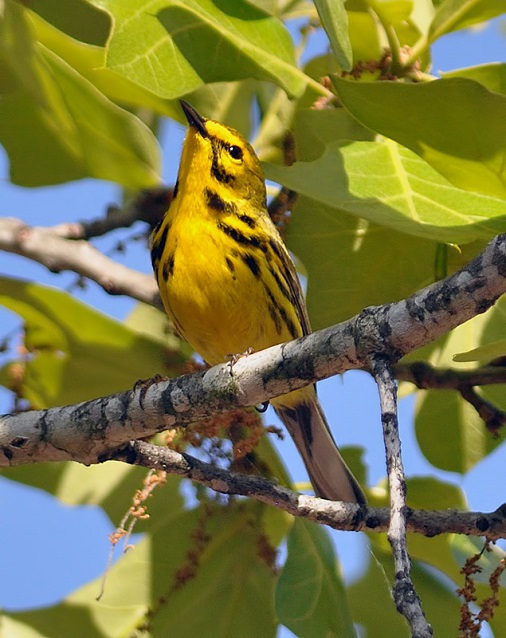Prescribed burning in the Ozarks is for the birds, but it is also for the elk, deer, wildflowers, pollinators, and the resiliency of the Ozarks to climate change.
What Happened?

NPS Photo/Dan Drees
Prescribed burning in the Ozarks is for the birds, but it is also for the elk, deer, wildflowers, pollinators, and the resiliency of the Ozarks to climate change. In recognition of the positive contribution that prescribed fire can make when applied wisely, the Wildlife Conservation Society, Rocky Mountain Elk Foundation, and National Wild Turkey Federation all made significant financial donations to facilitate the 1,836-acre Jerktail Mountain prescribed fire on lands owned by the National Park Service and Pioneer Forest.
In March of 2015 the National Park Service’s Ozark National Scenic Riverways (ONSR) partnered with staff from Pioneer Forest and The Nature Conservancy to successfully complete the Jerktail Mountain prescribed burn. Pioneer Forest is the land management entity of the L-A-D Foundation, which is both a non-profit organization and the largest private land ownership in Missouri.
The L-A-D Foundation, founded by Leo A. Drey, is cherished by Missourians for its superb stewardship of its lands and its cordial invitation to the public to responsibly enjoy the many natural treasures that the Foundation owns. Most of the foundation’s 147,000 acres are in the Current River watershed where they border more than 80 miles of the Ozark National Scenic Riverways.
How Do We Know This Was Successful?

Dan Swofford
Based on data collected in 2016, average species richness of native wildflowers and grasses increased by 70 percent on two glade monitoring plots and by 120 percent on two woodland monitoring plots.
Although the Current and Jacks Fork rivers are the preeminent natural resources of this spectacular park, the rugged lands adjoining these rivers harbor fire-benefitted animals and plants, including some that are becoming increasing rare on the Ozark landscape.
The prairie warbler inhabits rocky open glades on Jerktail Mountain that were becoming overgrown with eastern red cedar trees. The prairie warbler population nationwide is estimated to have declined more than 70 percent since 1966, but monitoring of Ozark populations has found them to be 27 times more abundant on fire-managed glades than unmanaged glades.
These beautiful songbirds have increased because fire replaces leaf litter and woody brush with an abundance of native wildflowers and grasses. This increase in non-woody plant diversity and abundance normally benefits deer and elk, but it also typically results in greater insect diversity and abundance. This results in better survival of prairie warbler nestlings.
Why Does It Matter?
Greater insect diversity and abundance also feeds more turkey, quail, bats, and many other animals. Fire management can result in healthier populations overall of insect pollinators, if ample unburned areas are left within or near the fire management unit. Although there are typically winners and losers when change occurs, in Ozark glade and woodland natural communities most species are benefitted by the proper application of dormant-season fire.
The Wildlife Conservation Society saw the Jerktail Mountain prescribed fire as an opportunity to help improve populations of declining wildlife species, and as an opportunity to maintain large assemblages of species that are known to be resistant to heat and drought stress. If the future climate of the Ozarks becomes hotter and drier, then the glade and woodland natural communities that were maintained by prescribed burning should expand to fill the void left behind by species that preferred a cool and wet climate.
For more than 60 years the L-A-D Foundation’s Pioneer Forest has demonstrated that its single-tree selection approach to timber harvesting is both economical and sustainable. Now Pioneer Forest has also demonstrated that there is a place for the wise use of landscape scale prescribed fire in the holistic stewardship of its vast land ownership, thanks to its partnership with ONSR and many other resource stewardship organizations.
Contact: Daniel Drees, Fire Ecologist
Email: Daniel_drees@nps.gov
Phone: (573) 323-8027
Last updated: December 15, 2017
